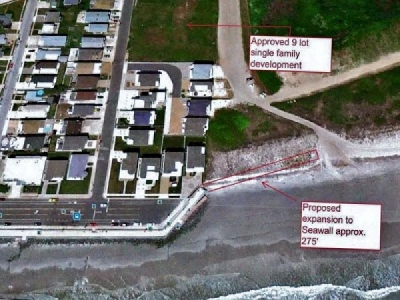
Posted on November 14, 2017
By Ray Schweibert, ShoreNewsToday
City Manager Ed Stinson said Brigantine received approval from the Army Corps of Engineers recently for a project aimed at protecting residents and property owners from storm surges and tidal flooding, but the approval fell short of what the city was hoping for.
Brigantine is in negotiations with the U.S. Army Corps of Engineers Bureau of Coastal Engineering Philadelphia Division to extend its north-end sea wall 275 feet to the north, and possibly farther if reconfiguration of its north-end four-wheel-drive access road can be arranged.
That project has already been approved by the Army Corps Continuing Authorities Program, or CAP, which means that a federal interest determination, or FID, has been approved and the project is moving forward. A municipality receives a FID when a feasibility study determines that a potential project’s cost will be outweighed by its benefits in the long haul.
Several more steps have to happen before the project comes to physical fruition, and that could be five or more years from now, Stinson said.
Brigantine was also seeking Army Corps CAP approval to install three groins, or rock-pile jetties, adding to the six the city has in place, but Stinson said the Army Corps declined to include them.
The six groins are at six-block intervals south of Roosevelt Boulevard. Over time the sections closest to land have become covered with sand and are only partially visible at extreme low tides, but they continue to do the job of slowing down beach erosion. The new ones sought would be placed at Fifth Street North, 10th Street North and 15th Street North.
“They didn’t rule out doing it, but they said they would need to be done as a modification to the current beach-replenishment arrangement we have with the Army Corps, which was a little disappointing,” Stinson said.
Brigantine has an agreement with the Army Corps for scheduled beach replenishment every six years, and flood control and coastal emergency storm-damage replenishment when needed. A flood control and storm-damage replenishment project is scheduled to start Nov. 24 that will replace about 750,000 cubic yards of sand washed away by winter storm Jonas in 2016.
Extending the sea wall would be a proven solution to blocking storm surges and protecting property on the north end, Stinson said. Installing groins, on the other hand, might prove effective in retaining sand on the beaches most subject to having it wash away more quickly, which are always those north of Roosevelt Boulevard. The Army Corps’ reluctance to back the project stems from its perceived cost effectiveness, according to the city manager.
“We’ve had the beach-fill project going on for about the past 15 years and it’s been effective, so now the problem is, how do we convince them to do the groins?” Stinson said, noting that U.S. Rep. Frank LoBiondo’s announced retirement this week came as bad news regarding the situation.
As a member of the House Transportation and Infrastructure Committee, LoBiondo was a driving force in Congress in helping Brigantine achieve such goals.
The sea wall and its planned extension may be viewed by the Army Corps as enough of a stop-gap to protect properties in the north-end area, but installing groins, which is an expensive undertaking, may be considered a nonessential measure on top of the wall improvements and scheduled beach replenishments, Stinson said.
“They didn’t say no, but they might ask where the benefit is to putting the groins in,” he said.
“We have a sea wall there, we’re planning to extend the sea wall, so there’s the protection for all the homes, which is something that can be measured monetarily. Putting the groins in would help to keep the sand in place, and maybe delay the frequency of replenishment, but would that be enough to make it more cost effective? If the groins slowed down the erosion, and instead of every six years they replenish the beaches every 10, would that make it cost effective?
“I’m not sure they can measure that,” he said. “That’s the challenge we’re going to have. We’ll keep trying. It’s good news, it’s just not the home run we were hoping for.”
Source: ShoreNewsToday





